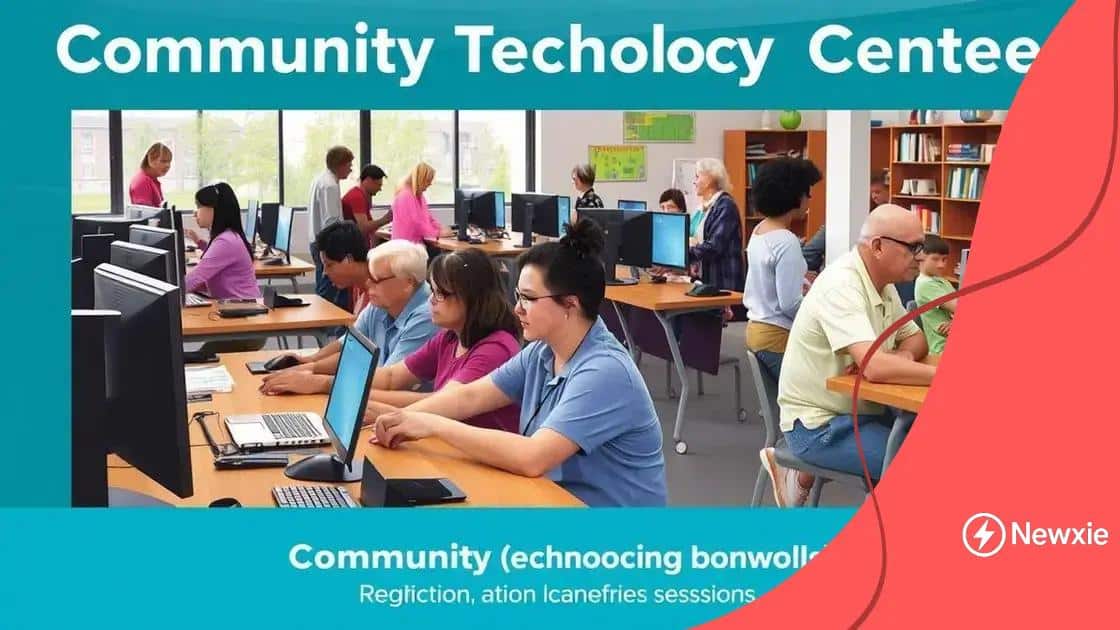Bridging the technology gap in underserved communities

Anúncios
Bridging the technology gap in underserved communities involves improving access to digital tools, enhancing education, and fostering community initiatives that empower individuals while addressing economic and infrastructural challenges.
Bridging the technology gap in underserved communities is essential for creating equitable opportunities. Have you ever wondered how access to technology could change lives? In this article, we’ll discover the transformative power of technology and what steps are being taken to ensure everyone can benefit.
Understanding the technology gap
Anúncios
Understanding the technology gap is crucial to identifying how we can create opportunities for everyone. In many underserved communities, access to technology is limited, which affects education, job opportunities, and healthcare. By addressing this gap, we can empower individuals and promote growth.
What is the technology gap?
The technology gap refers to the disparity in access to digital technology and the internet. This gap exists not only between countries but also within local communities. Some individuals have the latest devices and high-speed connections, while others struggle to access basic technology.
Key factors contributing to the technology gap
- Economic barriers: Many people in underserved communities cannot afford devices or internet plans.
- Lack of infrastructure: Some areas do not have the necessary infrastructure to support reliable internet service.
- Educational resources: People may lack knowledge about how to use available technology, hindering their ability to benefit from digital advancements.
- Government policies: Policies may not prioritize technology access for all, leading to inequities.
Bridging this gap requires a multifaceted approach. Education and training programs can help individuals learn how to use technology effectively. Additionally, improving infrastructure and providing affordable access to devices can make a significant difference. Community centers can serve as hubs for technology training and resources.
Engaging with local organizations and government bodies is also vital. Through collaboration, communities can create initiatives that promote technology access and education. These efforts can transform lives and open doors to new opportunities.
Anúncios
The impact of technology on underserved communities
The impact of technology on underserved communities is profound and far-reaching. Access to digital tools can significantly change lives, providing new opportunities in education, employment, and healthcare. When individuals have the means to use technology, they can connect with resources and services that might otherwise be out of reach.
Enhancing education
Technology creates new pathways for learning. Online resources allow students in underserved areas to access quality educational materials. Tutors and online courses help bridge the gap in skills and knowledge that many face. Schools can integrate digital tools, making learning more interactive and engaging.
Improving job opportunities
In the job market, technology opens doors for individuals. Many jobs require basic digital skills, and access to technology can help people improve their resumes and gain employer attention. Online job boards and LinkedIn can connect job seekers with potential employers.
- Remote jobs: As more companies adopt remote work, having technology skills becomes even more crucial.
- Skill development: Online platforms allow individuals to learn new skills that are in demand.
- Networking: Technology enables networking with professionals and joining supportive communities.
Healthcare access also improves with technology. Telehealth services provide remote medical consultations, making healthcare more accessible to those without transportation or who live in rural areas. Patients can manage their health from home, receiving advice and prescription refills without needing to visit a clinic in person.
Furthermore, technology fosters community engagement. Social media and other online platforms allow individuals to come together, share information, and advocate for their needs. This can lead to grassroots movements that prompt local change, improving overall community well-being.
Successful initiatives bridging the gap

Successful initiatives bridging the technology gap have emerged in various communities, showcasing innovative solutions to address the needs of underserved populations. These programs often focus on providing access to technology and education, which are essential for empowering individuals and transforming lives.
Community Technology Centers
Many cities have established community technology centers to provide free access to computers and the internet. These centers also offer training programs that teach essential digital skills. This helps residents learn how to navigate online resources, apply for jobs, and improve their resumes.
Mobile Technology Units
Mobile technology units are another effective way to reach underserved areas. These units travel to remote locations, bringing technology resources directly to the community. They often provide workshops on using digital tools and understanding online safety.
- Workshops: These units conduct hands-on workshops that help people get comfortable with devices.
- Access to resources: They offer educational materials and resources for individuals seeking to improve their skills.
- Community partnerships: Collaborations with local organizations enhance the program’s effectiveness.
Partnerships with local schools can also provide crucial support. Some schools create programs that focus on after-school technology training. By collaborating with local businesses, they can offer internships that give students real-world experience in technology-related fields. This not only improves skills but also helps students build connections and professional networks.
Nonprofit organizations play a vital role as well. Many nonprofits specifically target the technology gap by creating programs that distribute devices to families in need. They provide training sessions and ongoing support to ensure families can utilize their new technology effectively.
Challenges and solutions in technology access
Challenges in technology access are significant in underserved communities, where many individuals face barriers to gaining the digital tools they need. These challenges range from economic issues to lack of infrastructure, highlighting the importance of addressing the technology gap.
Economic barriers
Many families in these communities cannot afford devices or internet service. The cost of technology can be prohibitive, keeping individuals from accessing essential resources. Programs can help by providing low-cost devices or subsidized internet access, helping to reduce this financial strain. Some local initiatives even offer loans for families to purchase technology.
Infrastructure limitations
The lack of proper infrastructure is another challenge. In some areas, reliable internet service is not available, which limits access to online resources. Expanding broadband services is crucial to overcome this barrier. Communities can advocate for local governments to invest in infrastructure projects that bring high-speed internet to all residents.
- Public-private partnerships: Collaborations between tech companies and local governments can boost infrastructure development.
- Community Wi-Fi: Offering free public Wi-Fi in community spaces can bridge the access gap.
- Advocacy groups: These groups can push for policy changes that prioritize technology access in underserved areas.
Additionally, digital literacy plays a significant role in improving technology access. Many individuals may not know how to use devices effectively or navigate the internet. Educational programs focused on technology skills can empower individuals to make the most of available resources. Libraries and community centers can host workshops to teach these important skills, helping residents feel more confident with technology.
Finally, privacy and security concerns can also hinder access. Many people are hesitant to use technology due to fears about data security. Providing clear information on how to safely navigate the internet and protect personal data can build trust within the community. Local organizations can offer resources and support to help individuals recognize the importance of safe online practices.
The future of technology in disadvantaged areas
The future of technology in disadvantaged areas looks promising, with various initiatives aimed at improving access and education. As communities become more aware of the technology gap, efforts to bridge this divide are gaining momentum. Understanding the potential advancements and their implications is essential for creating lasting change.
Emerging technologies
Emerging technologies like artificial intelligence, blockchain, and 5G networks hold great promise for disadvantaged areas. These innovations can enhance communication, streamline services, and improve access to information. By integrating these technologies, communities can foster economic growth and attract investments.
Educational opportunities
Education is a key component in shaping the future of technology. Programs that focus on teaching STEM skills can prepare the next generation for careers in tech. Schools can partner with local businesses to create internships and mentorship opportunities. This hands-on experience allows students to apply what they learn and gain insights into the tech industry.
- Online learning platforms: Online resources can supplement education and provide accessible training.
- After-school programs: Offering tech-based after-school programs can help students build skills in a fun environment.
- Scholarships and grants: Providing financial support for higher education in tech fields encourages more students to pursue these careers.
Community involvement is crucial as well. Local organizations can arise to support technology initiatives, fostering a culture of innovation and collaboration. Events such as hackathons and tech fairs can engage residents and encourage problem-solving through technology. By bringing people together, these events can spark new ideas and partnerships.
Moreover, government policies can play a significant role in shaping the future. Advocating for policies that prioritize internet access and investment in tech infrastructure is essential. Governments can also provide funding for programs centered around digital literacy and technology access, ensuring that all community members can benefit from advancements.
FAQ – Frequently Asked Questions about Bridging the Technology Gap
What are the main challenges facing underserved communities in technology access?
The main challenges include economic barriers, lack of infrastructure, digital literacy issues, and privacy concerns.
How can educational programs help improve technology access?
Educational programs can teach essential digital skills, preparing individuals to use technology effectively and confidently in their daily lives.
What types of community initiatives are effective in bridging the technology gap?
Successful initiatives often involve community technology centers, mobile technology units, and partnerships with local schools and businesses.
How can government policies impact technology access in disadvantaged areas?
Government policies can prioritize funding for infrastructure, support educational programs, and encourage partnerships that improve technology access.
SEE MORE CONTENT




